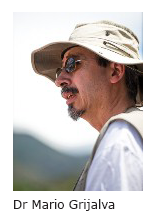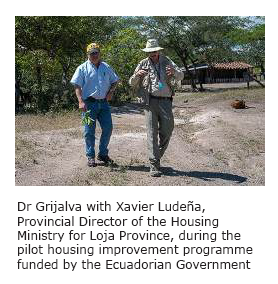 When Mario Grijalva left his native Ecuador for graduate studies in the United States, he had never heard of Chagas disease. Neither had most of the rural populations who lived with and died of the disease, the physicians who mistook its symptoms for cardiac problems, nor politicians. Grijalva, who had returned to study Chagas disease, had his work cut out for him.
When Mario Grijalva left his native Ecuador for graduate studies in the United States, he had never heard of Chagas disease. Neither had most of the rural populations who lived with and died of the disease, the physicians who mistook its symptoms for cardiac problems, nor politicians. Grijalva, who had returned to study Chagas disease, had his work cut out for him.
He recalls meeting the director of epidemiology at Ecuador's Ministry of Health. He says: “He said that there is no Chagas disease in Ecuador. Maybe a little, but nothing important.”
With sketchy and outdated epidemiological information, there had been virtually no research into the disease for over a decade, putting Ecuador years behind other endemic countries such as Brazil and Argentina in managing the disease.
Grijalva, who specialized in immunology and molecular parasitology at the Ohio University Tropical Disease Institute (TDI), looked at blood banks in Quito, a supposedly nonendemic region of Ecuador. To his horror he discovered that an important portion of donated blood came from donors infected with parasites that cause Chagas disease.
Grijalva’s work, then as now, was to establish that Chagas disease is a problem that needs urgent attention.
Making Chagas disease official
That's where TDR came in. At a time when Chagas disease did not officially exist, TDR’s first grant in 1999 enabled Grijalva to analyse blood samples from poor rural populations across the Ecuadorian Amazon, and later coastal areas. He established that Chagas disease was widespread.
The observations were really scary. For the first time, we had scientifically-obtained evidence that there was a very serious problem.
The grant also helped Grijalva to test more blood bank samples. With no pre-existing infrastructure – not even micropipettes – Grijalva resorted to mixing his own reagents at TDI and bringing equipment from the United States to Ecuador to be used to screen blood.
By the time he was a faculty member at the Ohio University Heritage College of Osteopathic Medicine, his own research team blood-bank hopped around Ecuador documenting precisely the precarious state of blood screening. They found that practices for Chagas disease, HIV, syphilis and hepatitis B and C screening were woefully inadequate.
“The observations were really scary,” he says, “for the first time, we had scientifically-obtained evidence that there was a very serious problem.”
Publishing results about contaminated blood internationally proved enough of an incentive for the overhaul of the blood bank system. Screening was made mandatory and proper training required for blood bank screening technicians. Grijalva’s group established these training and certification programmes and even today, conducts external quality control investigations in all blood banks of the country.
Using research to advocate for change
But proving Chagas disease was widespread in poor communities was not enough of an incentive for policy-makers to introduce measures to control it. “The research we produced was put in a drawer and forgotten. I felt really bad,” says Grijalva, now director of TDI.
So, Grijalva shifted focus from seroprevalence in humans to a community-based approach. He took research teams directly to the rural areas, hiking for hours to study animal reservoirs, insect vectors and people where the parasite lives.
Armed with proof, they eventually showed local officials precisely how the disease moves. “We showed them under the microscope the trypanosomes we extracted from the rats found in a day-care centre”, for example.
At last Ecuador created a National Chagas Disease Control Program in 2005, spraying homes infested with the triatomine insects that transmit Chagas disease with insecticides. Grijalva, who takes undergraduate, graduate and medical students into the field every year, is confident that these rural communities now recognize Chagas disease and these insects.
TDR was instrumental in helping the research that changed policy-makers’ minds. Its funds established Grijalva’s base in Quito – the Center for Infectious Disease Research (CIDR) – on the campus of Catholic University of Ecuador. And its research capacity strengthening grants were used to start an ethics committee and importantly, training so the team could focus on new areas, such as basic research on triatomines and trypanosomes. That, in turn, has helped improve the Ecuadorian control programme.
 Dr Jorge Monroy, national programme coordinator for Chagas disease in Ecuador, agrees that Grijalva's group's work – from genetic typing of Chagas disease vectors to blood bank screening and laboratory evaluations – has been crucial. He adds that
identifying vector species in the provinces of Ecuador is “data of extreme importance” in developing entomological maps of the country's different provinces. “Dr Mario Grijalva and his team have had a substantial input into the control
of Chagas disease in Ecuador,” he says. “It’s important to note that this is the only agency that the Ecuadorian Public Health Ministry has assigned to the surveillance of the disease.”
Dr Jorge Monroy, national programme coordinator for Chagas disease in Ecuador, agrees that Grijalva's group's work – from genetic typing of Chagas disease vectors to blood bank screening and laboratory evaluations – has been crucial. He adds that
identifying vector species in the provinces of Ecuador is “data of extreme importance” in developing entomological maps of the country's different provinces. “Dr Mario Grijalva and his team have had a substantial input into the control
of Chagas disease in Ecuador,” he says. “It’s important to note that this is the only agency that the Ecuadorian Public Health Ministry has assigned to the surveillance of the disease.”
From one man-mission to research hub
Despite such progress, the research continues. That's because so much more needs to be understood: geographical differences in sylvatic triatomine species; why commercial diagnostic tests do not work accurately in Ecuador; how housing and social development could impact on Chagas disease.
More advocacy is needed too, says Grijalva. Doctors still miss symptoms and lack of awareness amongst policy-makers means diagnostic, treatment and control coverage is still patchy.
That's why more researchers are needed. For years Grijalva was the only principal investigator working on Chagas disease at CIDR. A TDR grant helped establish a doctoral programme that has produced several new investigators who now work at the research centre in Quito.
Importantly those grants have given them leverage to tap other high-profile funders such as the United States’ National Institutes of Health and the European Union. “TDR grants gave us credibility and political protection,” says Grijalva. Indeed they have helped attract other funding to build Ecuador’s brand new Center for Infectious Disease Research and Training that will house 22 research groups working on Chagas disease and other diseases from tuberculosis and malaria to dengue.
Colleagues recognize the impact of Grijalva’s tireless advocacy work. Edwin Rowland, Grijalva PhD supervisor at the Ohio University, who first inspired him to embark on Chagas disease research says: “His ability comes to bear when he collaborates, coordinates and, most importantly, works through the various political entities, to get the job done. Not many expat scientists can get a building built for them in their home country.”
For more information, please contact:
Makiko Kitamura
TDR Communications Officer
Telephone: +41 22 791 2926
email: kitamuram@who.int
To contact Dr Grijalva:
Dr Mario Grijalva
Director – Tropical Disease Institute
Professor – Biomedical Sciences Department
Heritage College of Osteopathic Medicine
Ohio University
Director – Center for Infectious and Chronic Disease Research
School
of Biological Sciences
Catholic University of Ecuador, Quito
740 593 2192
email: grijalva@ohio.edu

